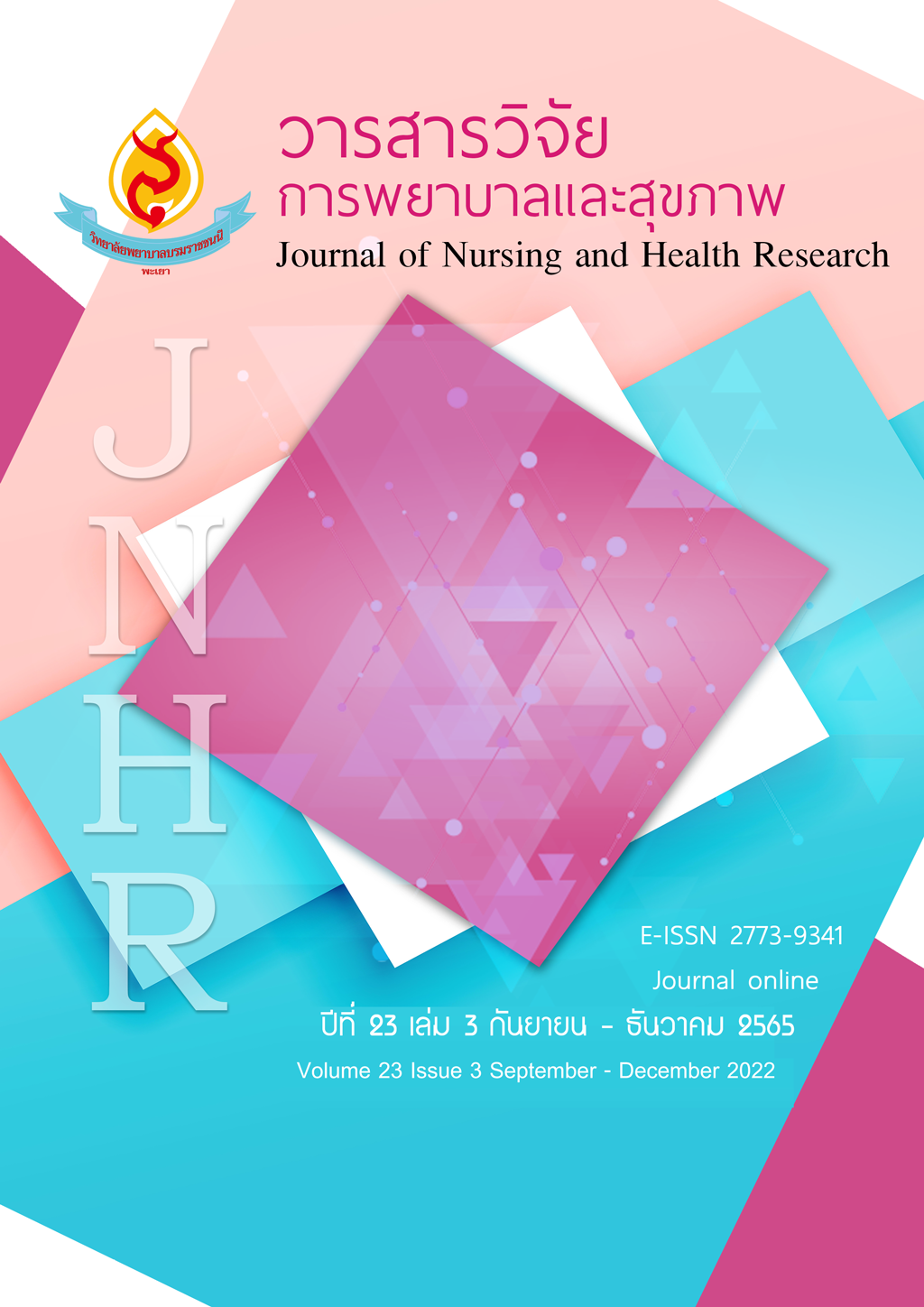ปัจจัยทำนายพฤติกรรมการปกป้องสุขภาพทางเพศของเยาวชนไทย
คำสำคัญ:
ความเสี่ยงของการมีเพศสัมพันธ์ , การปกป้องสุขภาพทางเพศบทคัดย่อ
การศึกษาเชิงพรรณนาแบบภาคตัดขวางนี้ มีวัตถุประสงค์เพื่อศึกษาปัจจัยทำนายพฤติกรรมการปกป้องสุขภาพทางเพศของเยาวชนไทย เก็บรวมรวมข้อมูลในสถานศึกษา 12 แห่ง จากภาคเหนือ ภาคกลาง ภาคใต้ และภาคตะวันออกเฉียงเหนือทั้งโรงเรียนระดับมัธยมศึกษา วิทยาลัยอาชีวศึกษา สถาบันอุดมศึกษา อย่างละ 1 แห่งในแต่ละภาค กลุ่มตัวอย่างจำนวนทั้งสิ้น 1,209 คน รวบรวมข้อมูลโดยใช้แบบสอบถามพฤติกรรมเสี่ยงของการมีเพศสัมพันธ์ การรับรู้ความเสี่ยงปัญหาสุขภาพทางเพศ และพฤติกรรมการปกป้องสุขภาพทางเพศของเยาวชนไทย โดยมีค่าสัมประสิทธิ์แอลฟ่าครอนบาคเท่ากับ .93 และ .91 ตามลำดับ ผลการศึกษา พบว่า 1 ใน 3 ของกลุ่มตัวอย่าง เคยมีประสบการณ์มีเพศสัมพันธ์โดยอายุเฉลี่ยของการมีเพศสัมพันธ์ครั้งแรก 16.56 ปี (SD=2.07 ปี) อายุต่ำสุดที่มีเพศสัมพันธ์ครั้งแรกเท่ากับ 10 ปี และมีเพียง 1 ใน 3 เท่านั้น ที่ใช้ถุงยางทุกครั้งเมื่อมีเพศสัมพันธ์ นอกจากนี้ยัง พบว่า เยาวชนที่มีประสบการณ์มีเพศสัมพันธ์มีการรับรู้ความเสี่ยงจากการมีเพศสัมพันธ์สูงกว่าแต่มีพฤติกรรมการปกป้องทางเพศที่ต่ำกว่าเยาวชนที่ไม่มีประสบการณ์มีเพศสัมพันธ์อย่างมีนัยสำคัญทางสถิติ (p<.01) นอกจากนี้การวิเคราะห์ปัจจัยทำนายพฤติกรรมการปกป้องทางเพศในกลุ่มเยาวชนด้วยสถิติวิเคราะห์ตัวแปรถดถอยเชิงเส้น พบว่า อายุ การศึกษาในระดับอาชีวศึกษา การอาศัยอยู่กับพ่อแม่ ประสบการณ์มีเพศสัมพันธ์ และการรับรู้ความเสี่ยงจากการมีเพศสัมพันธ์ สามารถร่วมกันทำนายพฤติกรรมการปกป้องสุขภาพทางเพศ โดยมีอำนาจในการทำนาย ร้อยละ 29.9 (R2= .299, F=85.03, p<.01) ผลการศึกษาในครั้งนี้ เป็นการยืนยันว่า การมีสุขภาพทางเพศ เป็นวิถีทางเพศที่พึงพอใจและปลอดภัย ความคิดทางบวก เคารพต่อวิถีชีวิตทางเพศที่แตกต่างกันของบุคคล ปราศจากการตีตราและการเลือกปฏิบัติ การมีเพศสัมพันธ์ของเยาวชนเป็นวิถีชีวิตในสังคมที่ต้องให้การยอมรับ เพื่อให้เยาวชนสามารถเข้าถึงข้อมูลและทรัพยากรที่จำเป็นเพื่อการปกป้องสุขภาพทางเพศของตนเองได้อย่างปลอดภัย
เอกสารอ้างอิง
กรกวรรษ ดารุนิกร, ชนัญญา จิระพรกุล และ เนาวรัตน์ มณีนิล. (2562). ปัจจัยที่มีความสัมพันธ์กับการมีคู่นอนหลายคนของวัยรุ่นในสถานศึกษา จังหวัดขอนแก่น. วารสารวิจัยสาธารณสุขศาสตร์มหาวิทยาลัยขอนแก่น, 12(1), 13-21.
ถนอม นามวงศ์, สุกัญญา คำพัฒน์ และ ปิญชาน์ ปรัชญคุปต์. (2562). อัตราความชุกและปัจจัยที่สัมพันธ์กับโรคติดต่อทางเพศสัมพันธ์ในกลุ่มเยาวชน จังหวัดยโสธร. วารสารโรคเอดส์, 31(3), 116-124.
ธนิดา ผาติเสนะ, จิรารัตน์ วิเศษสัตย์, ธิดาพร งวดชัย และ อัจฉราพรรณ ไทยภักดี. (2565). ความสัมพันธ์ระหว่างความรอบรู้ด้านสุขภาพกับพฤติกรรมการป้องกันการตั้งครรภ์ของนักศึกษาหญิงระดับอุดมศึกษา จังหวัดนครราชสีมา. วารสารราชพฤกษ์, 20(1), 71-81.
ปัญญ์กรินทร์ หอยรัตน์ และ ปราโมทย์ วงศ์สวัสดิ์. (2563). ปัจจัยที่มีอิทธิพลต่อพฤติกรรมการมีเพศสัมพันธ์ของนักเรียนชั้นมัธยมศึกษา. วารสารวิจัยสุขภาพและการพยาบาล, 36(1), 149-163.
เพ็ญพิไล ฤทธาคณานนท์. (2550). พัฒนาการมนุษย์ (พิมพ์ครั้งที่ 2). กรุงเทพฯ: ธรรมดาเพรส.
รวมพร คงกำเนิด, ศิริอร สินธุ, และชิตธนัช ทองคง. (2555). การรับรู้ความรุนแรงและการรับรู้โอกาสเสี่ยงของการติดเชื้อทางเพศสัมพันธ์ในวัยรุ่นผู้หญิงไทย. วารสารพยาบาลศาสตร์, 30(1), 61-69.
สำนักอนามัยเจริญพันธุ์. (2562). รายงานประจำปี 2562 สำนักอนามัยเจริญพันธุ์. เข้าถึงได้จาก https://rh.anamai.moph.go.th/th/department-yearly-report
สำนักอนามัยเจริญพันธุ์. (2564). รายงานประจำปี 2564 สำนักอนามัยเจริญพันธุ์. เข้าถึงได้จาก https://rh.anamai.moph.go.th/th/department-yearly-report
Alexopoulos, C. & Taylor, L.D. (2020). Paper risky business: sexual risk and responsibility messages in Teen Sex Romps. Sexuality & Culture, 24: 2161–2182. doi:org/10.1007.
Cohen, J. (1988). Statistical power analysis for the behavioral sciences, (2nd ed.). Hillsdale, NJ: Erlbaum
Ghebrehewet, S., Stewa, A. G., Baxter, D., Shears, P., Conrad, D., & Kliner, M. (2016). Health protection: principles and practice. OUP: Oxford.
Henderson, J. T., Senger, C. A., Henninger, M., Bean, S.I., Redmond, N., & O'Connor, E. A. (2020). Behavioral counseling interventions to prevent sexually transmitted infections: updated evidence report and systematic review for the US preventive services task force. JAMA, 18, 324(7), 682-699. doi: 10.1001/jama.2020.10371.
Jan, K. N., Champion, V. L, & Strecher, V. J. (2002). The Health Belief Model. In: Karen, G., Barbara, T. K., Viswanth. editors. Health behavior and health education: Theory, research, and practice. 3RD San Francisco: Jossey-Bass: 45-66.
Klu, D., Agordoh, P., Azagba, P., Acquah, E., Doegah, P., Ofosu, A., … Gyapong, M. (2022). Determinants of communication on sexual issues between adolescents and their parents in the Adaklu district of the Volta region, Ghana: a multinomial logistic regression analysis. Reproductive Health, 9(101). doi:org/10.1186/s12978-022-01402-0
Konggumnerd, R., Iraramalai, S., Sutharangsee, V., & Villarruel, A. M. (2009). Development and psychometric evaluation of the sexual health protection scale (SHPS) for thai female adolescents. Journal of Health Science. 18(1), 1-9.
Lowe, M., Sagnia, P. I. G., Awolaran, O., & Mongbo, Y. A. M. (2021). Sexual and reproductive health of adolescents and young people in the gambia: a systematic review. Pan African Medical Journal. 40, 1-10.
NwaozuruI, U., Blackstone, S., Obiezu-UmehI, C., Conserve, D. F., Mason, Uzoaru, S. F., … Iwelunmor. J. (2020). Psychosocial correlates of safe sex selfefficacy among in-school adolescent girls in Lagos, Nigeria. PLoS ONE, 15(6), 1-15. doi: 10.1371/journal.pone.0234788.
Osorio, A., Lopez-del Burgo, C., Ruiz-Canela, M., Carlos, S., & de Irala, J. (2015). Safe-sex belief and sexual risk behaviours among adolescents from three developing countries: a cross-sectional study. BMJ open, 5(4), e007826. doi: 10.1136/bmjopen-2015-007826
Pringle, J., Mills, K. L., McAteer, J., Jepson, R., Hogg, E., Anand, N., & Blakemore, S. J. (2017). The physiology of adolescent sexual behaviour: a systematic review. Cogent social sciences, 3(1), 1368858. doi: 10.1080/23311886.2017.1368858
Srijaiwong, S, Sindhu, S., Ratinthorn, A., & Viwatwongkasem, C. (2017). Factors influencing sexual behaviors among thai adolescents. Journal of Population and Social Studies, 25(3), 171–193. doi:10.25133/JPSSv25n3.002.
Shearer, E. & Wingo (2002). The concept of protection: a dimensional analysis and critique of a theory of protection. Advance of Nursing Science, 25(1), 65-78.
Sirirassamee, T., Yoelao, D., Mohan, K. P., & Limkhunthummo, S. (2018). The relationships between sexual risk behaviors and general health risk behaviors among unmarried youth in Thailand. SAGE open medicine, 6, 2050312118813284. doi: 10.1177/2050312118813284
Teye-Kwadjo, E., Kagee, A., & Swart, H. (2017). Predicting the Intention to use condoms and actual condom use behaviour: a three-wave longitudinal study in Ghana. Applied psychology. Health and well-being, 9(1), 81–105. doi: 10.1111/aphw.12082
Wiwattanacheewin, K., Sindhu, S., Teitelman, A., Maneesriwongul, W., & Viwatwongkasem, C. (2015). Predictors of intention to use HIV testing service among sexually experienced youth in Thailand. AIDS education and prevention: official publication of the International Society for AIDS Education, 27(2), 139–152. doi: 10.1521/aeap.2015.27.2.139
World Health Organization. (2017). Sexual health and its linkages to reproductive health: an operational approach. Retrieved from http://www.who.int/reproductivehealth/publications/sexual_health/sh-linkages-
ดาวน์โหลด
เผยแพร่แล้ว
รูปแบบการอ้างอิง
ฉบับ
ประเภทบทความ
สัญญาอนุญาต
ลิขสิทธิ์ (c) 2022 วารสารวิจัยการพยาบาลและสุขภาพ

อนุญาตภายใต้เงื่อนไข Creative Commons Attribution-NonCommercial-NoDerivatives 4.0 International License.



